The Little Dipper is a prominent asterism in the northern sky, formed by the brightest stars of the constellation of Ursa Minor, the celestial little bear.
Key Facts & Summary
- The Little Dipper is often confused for the whole constellation of Ursa Minor, just like the Big Dipper is confused with Ursa Major, the Great Bear, however, the Little Dipper is just the brightest part of Ursa Minor.
- The Little Dipper is formed out of the primary stars of Ursa Minor, however, they are not the only stars in the constellation.
- The handle of the Dipper is formed by the stars that mark the celestial Bear’s tail, while the Dipper’s cup is formed by the stars that mark the Beark’s flank.
- The seven stars that form the Little Dipper asterism are Polaris, Kochab, Yildun, Pherkad, Ahfa al Farkadain, Anwar al Farkadain, and Urodelus.
- The brightest star of the asterism, Polaris, is currently the North Pole Star, and the brightest star of Ursa Minor.
- Polaris reveals the location of the North Celestial Pole, being more accurate than any compass.
- This star is very useful to sailors since the star’s angle above the horizon can also be used to find your latitude on Earth.
- Kochab, the second-brightest star of Ursa Minor, is a former North Pole Star.
- The Little Dipper asterism can be seen as the handle of a ladle, hence the North American name.
- To find the North Pole Star – Polaris – one can use the stars Dubhe and Merak – which are part of the Big Dipper asterism – as pointer stars.
- The best time of the year to observe the Little Dipper is June, at around 21:00 – 9 p.m.
- In order to view the whole asterism, one needs good viewing conditions and very dark skies since the four stars lying between Polaris, Pherkad, and Kochab, are relatively dim.
The constellation of Ursa Minor was created by the Greek philosopher and astronomer, Thales of Miletus, around the year 600 BC from the stars that previously marked the wings of Draco, the celestial dragon.
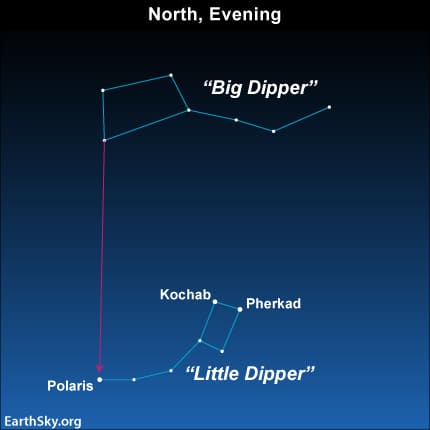
The constellation of Draco is still looping around Ursa Minor in the sky. Thales created the new constellation after Phoenician sailors had shown him how to use the stars of the Little Dipper to find north.
Since in his era, the North Celestial Pole was marked by the stars Kochab and Pherkad, the two stars were given the title of Guardians of the Pole.
Location
The Little Dipper is situated in the constellation of Ursa Minor, the 56th largest constellation in the sky. Ursa Minor spreads out for over 256 square degrees, being easy to spot since it hosts the north pole star.
The constellation has been traditionally important for navigation, particularly by mariners. Ursa Minor is located in the third quadrant of the northern hemisphere (NQ3).

- Right Ascension: 08h 41.4m to 22h 54.0m
- Declination: 65.40o to 90o
- Visible: between +90o and -10o
- Best Viewed: at 21:00 ( 9 p.m. ) during June
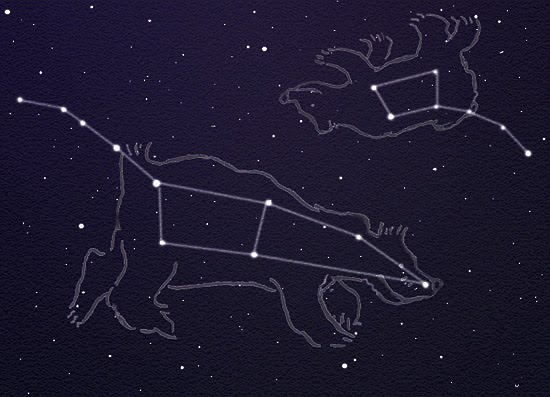
The neighboring constellations around Ursa Minor are Camelopardalis, Cepheus, and Draco. Ursa Minor belongs to the Ursa Major family of constellations, along with Coma Berenices, Bootes, Camelopardalis, Canes Venatici, Corona Borealis, Draco, Leo Minor, Lynx, and Ursa Major.
Finding the North Pole Star
The Little Dipper can be found after locating the Big Dipper. The stars Merak and Dubhe, two bright stars at the end of the Big Dipper’s bowl, point the way to Polaris, and thus the Little Dipper.
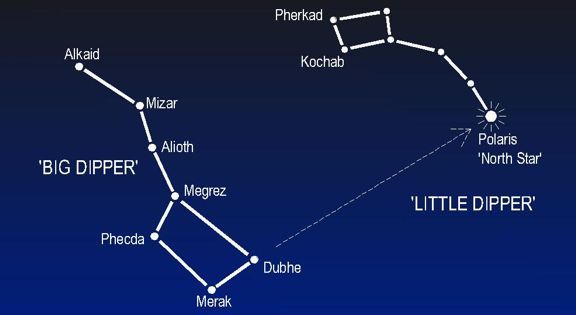
By following a line extended from these two stars upwards, out of the celestial bowl, one will find Polaris, the next bright star along the line. The distance from the Big Dipper to Polaris is around five times the distance between Merak and Dubhe, the pointer stars.
The Seven Stars of the Little Dipper
In order to view the whole asterism, one needs good viewing conditions and very dark skies since the four stars lying between Polaris, Pherkad, and Kochab, are relatively dim.
Polaris
Polaris, designated as Alpha Ursae Minoris, is a triple star system, and currently, it is our North Star or Pole Star, being the closest star to the north celestial pole.
The star system has an apparent magnitude of 1.98. The primary star, Polaris Aa, is a yellow supergiant located at around 433 light-years away from Earth.
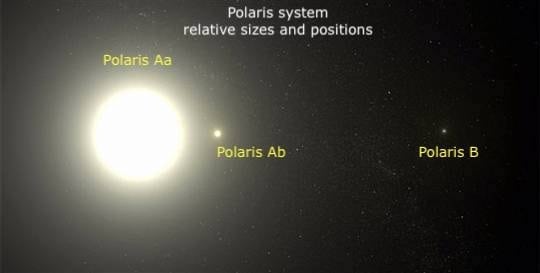
Polaris has 540% of our Sun’s mass, and it is overall around 50 times bigger than our Sun. It is a variable star, being around 2,900 times brighter than our Sun, holding the 50th position among the brightest stars in the night sky.
Polaris has been the North Pole star for more than 2,000 years, and it will remain so until the year 14,000, when Vega, a much brighter star will replace it since Earth’s northern axis will begin to move away from it. Until this happens, Polaris will remain more accurate than any compass.
Kochab
Kochab, designated as Beta Ursae Minoris, is the brightest star in the bowl of the Little Dipper asterism, and the second-brightest star in the constellation of Ursa Minor.
Kochab has an apparent magnitude of 2.08, it can be used by amateur astronomers as a precise guide for setting up a telescope, as the celestial north pole is located at 43 arcminutes away from Polaris, very close to the line connecting Polaris with Kochab.
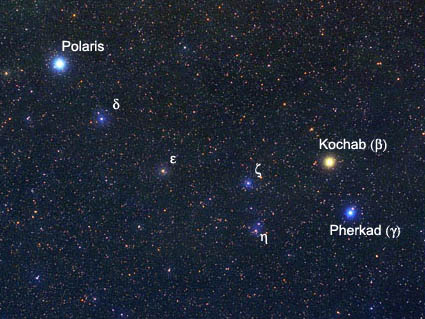
Kochab is a giant star located at 130.9 light-years away from us. It is 390 times brighter than our Sun, having 220% of its mass, and around 4.206% of its radius. Around the year 2500 BCE, Kochab was the north pole star.
Recently, it was discovered that a planet orbits Kochab, which is 610% more massive than Jupiter.
Pherkad
Pherkad, designated as Gamma Ursae Minoris, is a white supergiant star with an apparent magnitude of +3.05. Pherkad, along with Kochab, form the end of the dipper pan of the Little Dipper. Pherkad is situated at around 487 light-years away from us.
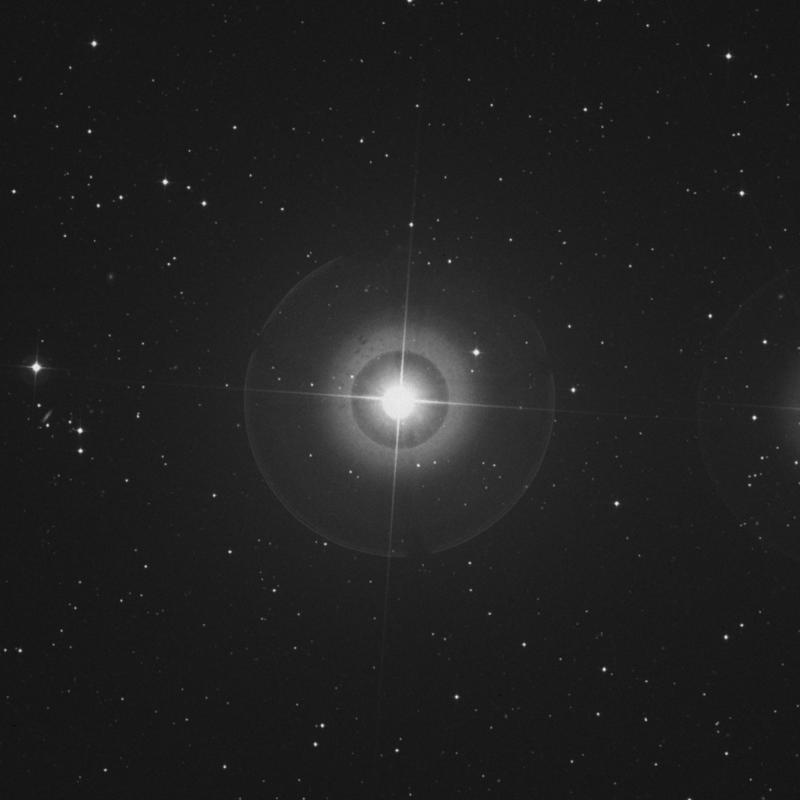
Pherkad is 1,100 times more luminous than our Sun, having 1500% of its radius, and it is also almost twice as hot.
This star is surrounded by a circumstellar disk of gas, most likely caused by its high rotational velocity ( 180 km / 111.8 mi per second). This may also be the reason why Pherkad varies in brightness.
Yildun
Yildun, designated as Delta Ursae Minoris, is a white-hued star with an apparent magnitude of 4.36, situated at around 172 light-years away from the Sun.
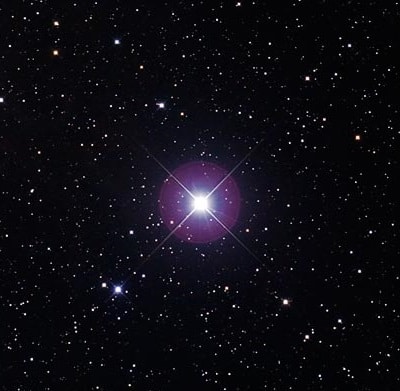
Yildun is around 47.7 times brighter than our Sun, having 235% of its mass, and 280% its radius. This star also rotates rapidly ( 154 km / 95.6 mi per second ), causing it to have an oblate shape with an equatorial bulge around 7% larger than its polar radius.
Urodelus
Urodelus, designated as Epsilon Ursae Minoris, is a binary star located at around 300 light-years away from us. It has an apparent magnitude of +4.19.

The primary star, Urodelus, is an evolved giant star, and together with its main-sequence companion star, they form an eclipsing binary system. The pair are drawing nearer to the Sun with a radial velocity of – 10.57 km / -6.5 mi per second.
Anwar al Farkadain
Anwar al Farkadain, designated as Eta Ursae Minoris, is a yellow-hued main-sequence star located at around 97 light-years away from us.
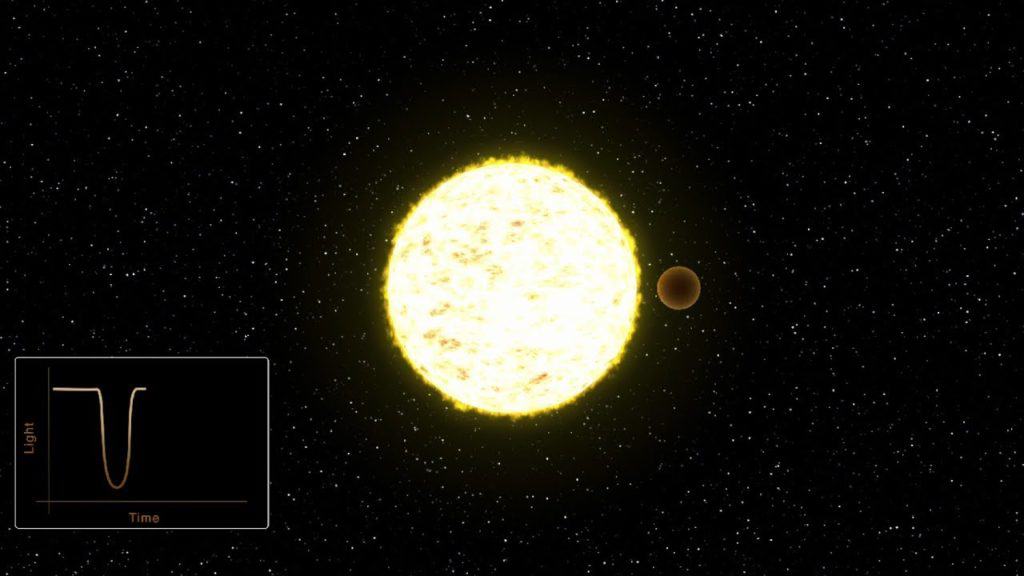
This star has an apparent magnitude of +4.95, having 135% of our Sun’s mass. The name “Anwar al Farkadain” means “the brighter of the two calves.”
Akhfa al Farkadain
Akhfa al Farkadain, designated as Zeta Ursae Minoris, is a main-sequence dwarf star located at around 380 light-years away from us. It has an apparent magnitude of +4.32.
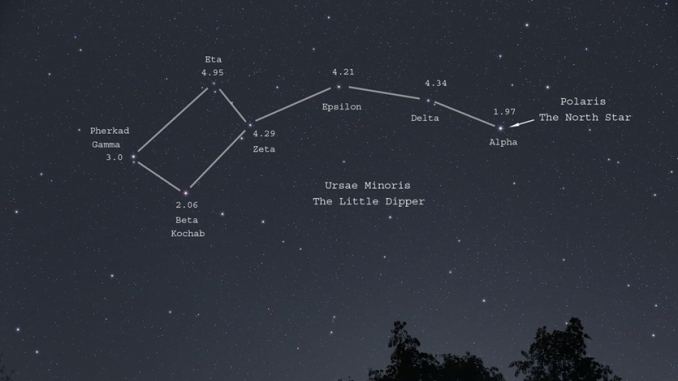
This star is around 227 times brighter than our Sun, having 340% of our Sun’s mass. The star’s name translates to “the dimmer of the two calves”.
Mythology
Ursa Minor is associated with two different myths. In the first myth, the constellation represents Ida, the nymph who took care of Zeus on the island of Crete when he was young, along with Adrasteia, the nymph who is associated with the larger Ursa Major constellation.
Zeus’s mother, Rhea, hid him on the island to protect him from his father, Cronus, who was afraid that his children will overthrow him. Cronus swallowed Zeus’s brothers and sisters but was tricked into swallowing a stone, thinking that it was Zeus.
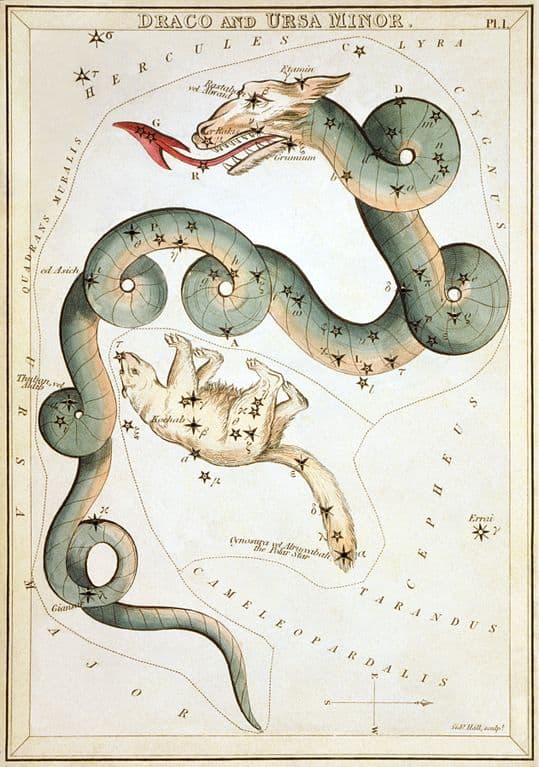
Zeus would eventually free his brothers and sisters and become the supreme god of the Olympians. In the second myth, the constellation represents Arcas, son of Zeus, and the nymph Callisto.
Callisto had sworn a vow of chastity to the goddess Artemis, however, she wasn’t able to resist Zeus’ advances, and thus they had a child, Arcas.
When Zeus’s wife, Hera, found out about the affair, she turned Callisto into a great bear. Callisto then roamed the forests for years until she came face to face with her son, Arcas.
Arcas was scared of the great bear in front of him and drew his spear, but Zeus quickly intervened to prevent a tragedy. He sent a whirlwind that scooped Callisto and Arcas into the heavens, where Callisto became Ursa Major, and Arcas, Ursa Minor.
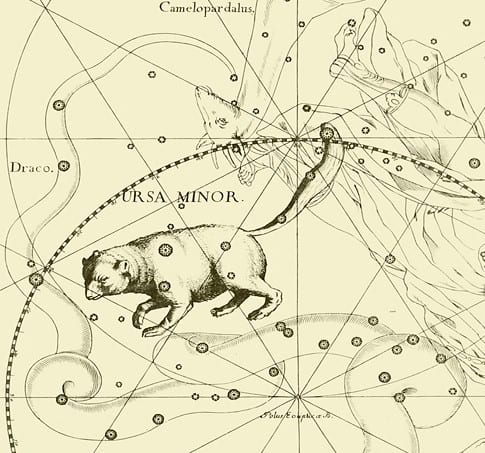
Arcas is frequently more associated with the Bootes constellation, the celestial herdsman. In an older myth, the seven stars that form the Little Dipper were said to represent the Hesperides, the seven daughters of Atlas.
Did you know?
- Since the seven bright stars of the Little Dipper point the way north, the Latin word for north is septentrio – derived from “septem triones” – or seven oxes.
- In Chinese astronomy, the main stars of Ursa Minor are divided between two asterisms: the Curved Array – formed by Polaris, Yildun, Urodelus, Zeta Ursae Minoris, Eta Ursae Minoris, Theta Ursae Minoris, and Lambda Ursae Minoris – the second asterism, Northern Pole, - is formed by Kochab and Pherkad.
- In Inuit astronomy, the three brightest stars of Ursa Minor – Polaris, Kochab, and Pherkad, were known as the Nuutuittut – “never moving”, though the term is more frequently used for Polaris alone.
- Before it became known as the Little Bear, Ursa Minor was known as the Dog’s Tail or Cynosura.
Sources:
Image Sources:
- https://earthsky.org/upl/2011/04/11Apr24_430.jpg
- https://www.constellation-guide.com/wp-content/uploads/2014/06/Little-Dipper-location.jpg
- https://sites.google.com/site/rzconstellationmythology/_/rsrc/1402064739286/ursa-minor/Ursa%20Major%20and%20Ursa%20Minor.jpg
- https://i.pinimg.com/originals/d6/97/97/d69797dd5e53c676e15349ac6cf588ed.jpg
- https://nineplanets.org/wp-content/uploads/2020/01/Polaris_system-relative-sizes-and-position.jpg
- https://www.daviddarling.info/images/Little_Dipper.jpg
- https://theskylive.com/sky/stars/star-images/57/5735_800.jpg
- https://freestarcharts.com/images/Articles/Constellations/Ursa_Minor/Polaris_Espenak.jpg
- https://www.constellation-guide.com/wp-content/uploads/2019/04/Algol-640x273.jpg
- https://alchetron.com/cdn/ursa-minor-b317ca79-af1d-40d0-bf03-dd47e5a3023-resize-750.jpeg
- https://i.ytimg.com/vi/Xh4ZFPPHkIM/maxresdefault.jpg
- https://upload.wikimedia.org/wikipedia/commons/thumb/3/3f/Sidney_Hall_-_Urania%27s_Mirror_-_Draco_and_Ursa_Minor.jpg/539px-Sidney_Hall_-_Urania%27s_Mirror_-_Draco_and_Ursa_Minor.jpg
- https://www.constellationsofwords.com/images/UrsaMinor.jpg
